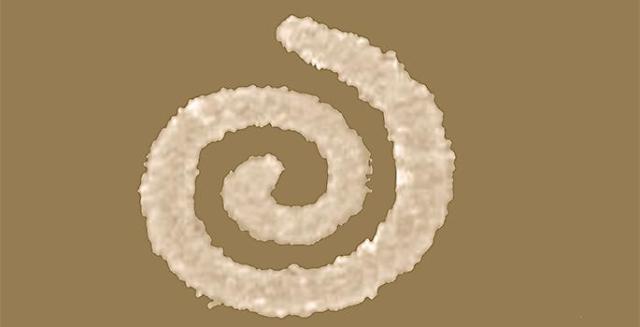The world's smallest continuous spirals have been created at Vanderbilt University in Nashville, Tennessee.
The spirals react in a unique way to polarized infrared light, which makes them very hard to counterfeit - this property could be used to prevent counterfeiting of currency, credit cards, or ID cards.
 Scanning electron microscope image of a single Archimedean nanospiral. Credit: Haglund Laboratory, Vanderbilt University
Scanning electron microscope image of a single Archimedean nanospiral. Credit: Haglund Laboratory, Vanderbilt University
Other researchers have created nanoscale spirals in the past, but this has usually been achieved by arranging nanoparticles in a spiral pattern.
In this new research, published in the Journal of Nanophotonics on May 21st, the nanospirals the smallest ever reported, and are also made of continuous material rather than an array of nanoparticles. A square of the Vanderbilt spirals with 100 on each side would be less than 1/100th of a millimetre wide.
They are certainly smaller than any of the spirals we've found reported in the scientific literature.
Roderick Davidson II, doctoral student at Vanderbilt
Because these spirals are smaller than the wavelength of visible light, they exhibit unusual optical properties. For example, when the spirals are lit up with infrared laser light, they produce visible blue light.
In fact, several crystals are known to produce this effect, which is known as harmonic generation or frequency doubling. The synthetic crystal beta barium borate was previously the strongest frequency doubler known; however, the new nano-spirals are capable of emitting even higher intensity blue light.
This is similar to what happens with a violin string when it is bowed vigorously. If you bow a violin string very lightly it produces a single tone. But, if you bow it vigorously, it also begins producing higher harmonics, or overtones.
The electrons at the center of the spirals are driven pretty vigorously by the laser's electric field. The blue light is exactly an octave higher than the infrared - the second harmonic
Richard Haglund, Stevenson Professor of Physics
The nano-spirals also exhibit a distinctive reponse to polarized light - the amount of blue light produced changes considerably as the angle of polarization is turned through 360°.
This effect is noticeable with linear polarized light, but even more pronouced with circular polarized light. When the direction of polarization matches the direction of the spiral, the electrons in the material are pushed towards the middle of the spiral, and a large amount of blue light is produced.
In contrast, when the opposite direction of polarization is applied (e.g. clockwise polarized light with anti-clockwise spirals), almost no blue light is emitted.
This is because the electrons are pushed to the outside of the spiral, which creates a destructive interference and weakens the optical effect.
Easy to detect, hard to duplicate
The gold nano-spirals in this study were created using scanning electron-beam lithography - platinum or silver would also be suitable materials, as they have similar corrosion-resistant properties.
The tiny amount of metal used in the spirals means they are not expensive to make - however, significant investment in the advanced lithography equipment is required. Because of the strong frequency doubling response to circularly polarized light, it would be fairly easy to check for the presence of the spirals on a surface with a device similar to a barcode reader.
The combination of these two properties - difficult to create, but easy to detect - makes the nano-spirals an ideal way of securing credit cards, currency, ID cards, or even chemicals and other substances against counterfeiting.
References and further reading